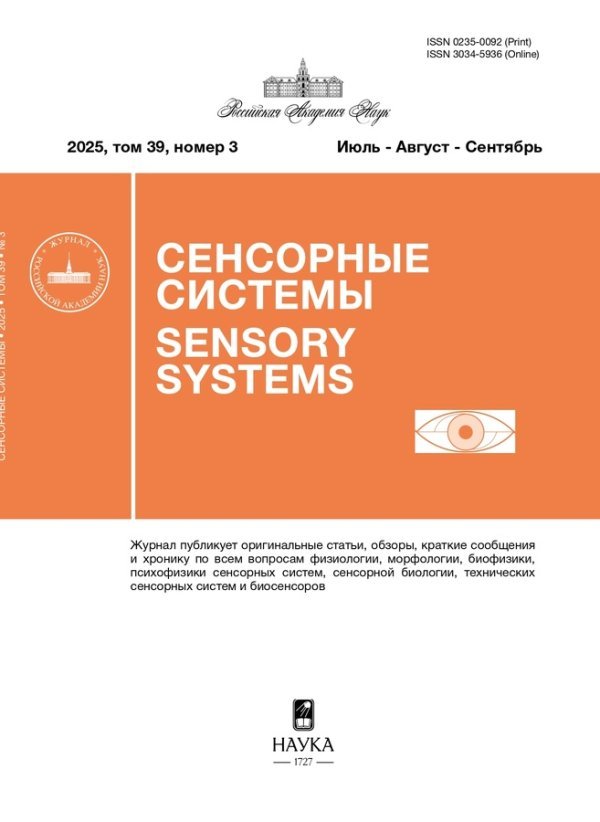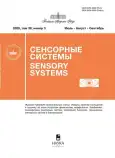Sensornye sistemy
The journal is publishing original papers, reviews, short reports and covers researches ranging over the fields of physiology, morphology, biophysics, psychophysics of sensory systems, sensory biology, biosensors and also sensor technology, basis of coding, and analysis of information about the environment and its transformation into perceived images – visual, auditory, olfactory, etc. as well as the algorithms of automatic analysis of sensory information, its representation, interpretation and usage for various driving devices.
Media registration certificate: ПИ № ФС 77 – 66699 от 28.07.2016
Current Issue
Vol 39, No 3 (2025)
ОБЗОРЫ
Free and bound fraction of cGMP in the outer segment of vertebrate photoreceptors
Abstract
The phototransduction cascade in vertebrate retinal photoreceptors uses cyclic guanosine monophosphate (cGMP) as a secondary messenger. The level of cGMP controls the conductance of channels in the plasma membrane of the cell, so the rate at which the level of cGMP changes is critical for photoreceptor responsiveness. There is an apparent contradiction between the high total concentration of cGMP in the outer segments and the high rate of cGMP exchange measured experimentally. The contradiction can be resolved by assuming that most of the cGMP is in the bound state and that the dynamic fraction is a small fraction of the total cGMP, but it is this fraction that is altered by light and controls channel conductance. In this review, we discuss the evidence for the partitioning of the total cGMP pool into bound and free fractions, the likely cGMP binding sites, and the possible functional significance of the existence of the two fractions.
Sensornye sistemy. 2025;39(3):3-12
 3-12
3-12


Disease detection by volatile organic compound analysis: I. Detection dogs
Abstract
The paper presents a review of modern research on the role of volatile organic compounds in the diagnosis of oncological diseases. The possibilities of canine olfaction, the use of detection dogs to identify diseased organisms among healthy organisms, the difficulties of this method, its comparison with instrumental methods of research are considered. The review includes the results of the authors’ own research and literature data on the specific features of the use of trained animals in the study of volatile organic compounds associated with the development of cancer. Possible ways of this research field development are suggested.
Sensornye sistemy. 2025;39(3):13-24
 13-24
13-24


Disease detection by volatile organic compound analysis: II. Direct sample injection mass spectrometry
Abstract
The results of the application of mass spectrometry with direct sample injection in the diagnosis of diseases in humans and laboratory animals are presented. Various methods for obtaining mass spectra of volatile organic compounds (VOCs) are considered, allowing VOCs analysis without using sample concentration and chromatographic separation. This approach, reminiscent of the work of trained sniffing dogs, ensures minimal sample analysis time and high sensitivity, which is extremely important for mass analysis. The authors’ own results on the development of a new method of VOC ionization for the analysis of biological samples are also presented.
Sensornye sistemy. 2025;39(3):25-37
 25-37
25-37


СЛУХОВАЯ СИСТЕМА
Response of Cells in the Temporal Cortex of a Non-Narcotised Cat to Human Snoring Sounds
Abstract
The response of cells in the temporal cortex of a non-narcotized cat to human snoring sounds was studied using a unique installation created by Ivan Pigarev. Thanks to this installation, it was possible to study the activity of cat neurons in a natural environment, recording a large number of parameters characterizing brain activity (local cortical potential and electroencephalogram) and important parameters of general body state (heartbeat, breathing, eye movement). The spike activity of individual cells or small groups of cells localized in cortical areas associated with sound analysis was considered. A significant number of these cells responded to a low-frequency intensive human snore sound with by modulating their firing frequency synchronized with the temporal features of the snore. These data allow us to reconsider some established postulates regarding the role of the auditory cortex based on experiments conducted mainly on anesthetized animals.
Sensornye sistemy. 2025;39(3):38-52
 38-52
38-52


Features of the influence of noise background on the choice of visual stimuli by children of early preschool age with different levels of anxiety
Abstract
The work continues a series of psychophysical experiments on studying the features of visual recognition of target stimuli of different colors or different sizes by early preschool children. For measurements, a previously developed game technique was used with a touch screen monitor to present images of geometric figures in silence and under an acoustic background corresponding to noise of “children’s polyphony”. The noise was fed through headphones with an intensity of 45 dB (the volume level of spoken speech). The experiments involved children with normal vision and hearing aged 3–4 years (n = 60) attending a city kindergarten. The data obtained on the extended sample confirmed the previously identified patterns: children of this age make a significantly worse choice based on the “color” feature than on the “size” feature (p <0.01); the introduction of the background noise of “children’s polyphony” increases the search time for a visual target, especially in the tasks of choosing the target “color”. A comparative analysis of the results in subgroups of children demonstrating different levels of activity and anxiety showed the manifestation of reliable differences, which is in good agreement with the preliminary data of the previous study. The results are of practical importance for the organization of preschool education, taking into account the characteristics of the psychophysiological profile of children and their level of anxiety, as well as special education for children with developmental delays.
Sensornye sistemy. 2025;39(3):53-63
 53-63
53-63


ЗРИТЕЛЬНАЯ СИСТЕМА
Virtual Selective Occlusion Based on Polarization 3D Technology in Functional Treatment of Binocular Vision Disorders
Abstract
Computerized functional treatment of binocular vision disorders, amblyopia and strabismus in particular, has opened fundamentally new opportunities for increasing the efficiency and decreasing time needed for treatment: improved correction and training procedures, new stimuli and exercises, previously practically unrealizable, and reduced physiological and psychological discomfort. Taking into account more than 10-year experience of using the “POISK” (the computer program developed in IITP RAS for amblyopia treatment) in laboratory and clinical conditions, the authors discuss the possibilities and features of employing virtual selective occlusion based on polarization separation of left and right images instead of traditional methods of occlusion. The analysis shows that, in the vast majority of cases, the traditional methods involving the long-term use of patching (occlusion therapy), which turns one of the eyes off from work, or regular injection of atropine to defocus retinal images (atropine penalization) can and should be replaced by more effective and less uncomfortable computer-based methods of virtual selective occlusion.
Sensornye sistemy. 2025;39(3):64-76
 64-76
64-76


OBITUARY
Петр Петрович Николаев
Sensornye sistemy. 2025;39(3):77-78
 77-78
77-78










